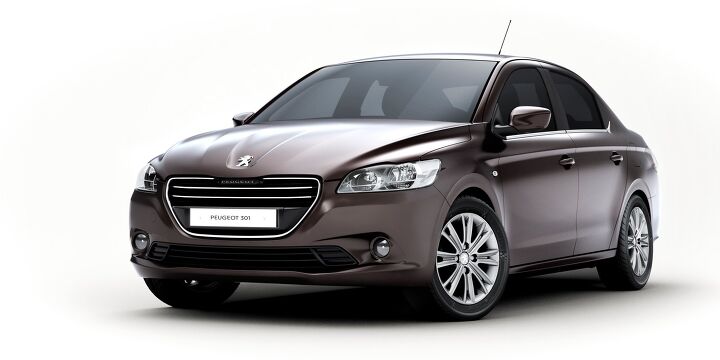PSA's Brand Strategy: Let's Make A Peugeot Sandwich
PSA announced their renewed brand strategy for their Peugeot and Citroen lines, and the situation has finally been clarified after frequent back and forth reports that contradicted one another. It turns out that PSA will employ a three-tier approach that is equally confusing, with Citroen as the lowest tier with Peugeot on top. But then there’s also Citroen’s DS line, which is supposed to be upscale itself. Confused? So are we.
A hand cheat sheet provided by PSA to Automotive News Europe outlines the “values” supposedly embodied by both Citroen and Peugeot.
PSA CEO Philippe Varin recently outlined the new product strategies for Peugeot and Citroen like this:
PSA was adamant that Citroen was not going to become a low-cost brand, but the next generation of vehicles will be positioned slightly lower than the current range. Does that mean the Hydramatic suspension, one of the brand’s hallmarks, will be gone? Let’s hope not. What will be happening is that Citroen vehicles will be positioned as “cheap premium” (whatever that means), with Peugeot being “premium” and to top it all off, Citroen’s DS line will be positioned as an even more premium range relative to Peugeot, if Automotive News has it right, which is difficult to ascertain, since PSA seems to change its positioning depending on what day of the week it is.
Further complicating matters is Peugeot’s schizophrenic offerings, including the low-cost 301 sedan which will be sold in emerging markets as a premium vehicle relative to the other low-cost competitors, if you buy into PSA’s spin. It’s a tough one to swallow, considering that Renault has poured so much time and effort into Dacia for the precise reason that the low-cost and premium brands should not mix.
Keen French car observers will also note that the brand values espoused here are backwards. Traditionally, Citroen had the elegant, dynamic designs and wild new technologies, while Peugeots were rugged and simple enough to endear themselves to the pied-noirs of Africa. Outside of France and Africa, Peugeot’s profile is basically nil – if the Citroen C6’s poor sales were an indication of how poorly premium French cars were received then the Peugeot 607 large sedan may have been the only offering to fare even worse, ending up largely in the hands of cab drivers.
The most succinct analysis of it all comes from Fitch Ratings, which noted
“We believe this strategy makes sense overall but carries substantial execution risk and could take many years to bear fruit. In particular, we are concerned that the existence of both entry-level/basic models and aspiring higher-end products within the two brands will not be easily understood and accepted by customers.”
More by Derek Kreindler
Latest Car Reviews
Read moreLatest Product Reviews
Read moreRecent Comments
- SCE to AUX My son cross-shopped the RAV4 and Model Y, then bought the Y. To their surprise, they hated the RAV4.
- SCE to AUX I'm already driving the cheap EV (19 Ioniq EV).$30k MSRP in late 2018, $23k after subsidy at lease (no tax hassle)$549/year insurance$40 in electricity to drive 1000 miles/month66k miles, no range lossAffordable 16" tiresVirtually no maintenance expensesHyundai (for example) has dramatically cut prices on their EVs, so you can get a 361-mile Ioniq 6 in the high 30s right now.But ask me if I'd go to the Subaru brand if one was affordable, and the answer is no.
- David Murilee Martin, These Toyota Vans were absolute garbage. As the labor even basic service cost 400% as much as servicing a VW Vanagon or American minivan. A skilled Toyota tech would take about 2.5 hours just to change the air cleaner. Also they also broke often, as they overheated and warped the engine and boiled the automatic transmission...
- Marcr My wife and I mostly work from home (or use public transit), the kid is grown, and we no longer do road trips of more than 150 miles or so. Our one car mostly gets used for local errands and the occasional airport pickup. The first non-Tesla, non-Mini, non-Fiat, non-Kia/Hyundai, non-GM (I do have my biases) small fun-to-drive hatchback EV with 200+ mile range, instrument display behind the wheel where it belongs and actual knobs for oft-used functions for under $35K will get our money. What we really want is a proper 21st century equivalent of the original Honda Civic. The Volvo EX30 is close and may end up being the compromise choice.
- Mebgardner I test drove a 2023 2.5 Rav4 last year. I passed on it because it was a very noisy interior, and handled poorly on uneven pavement (filled potholes), which Tucson has many. Very little acoustic padding mean you talk loudly above 55 mph. The forums were also talking about how the roof leaks from not properly sealed roof rack holes, and door windows leaking into the lower door interior. I did not stick around to find out if all that was true. No talk about engine troubles though, this is new info to me.


































Comments
Join the conversation
As a Citroen fan I say Peugeot deserves a very bad fate for doing this. Very bad, as in worse than Mazda's five-brand strategy from 1991...LOL :)
Citroen's novel suspension is hydropneumatic - not Hydramatic which is a GM auto transmission